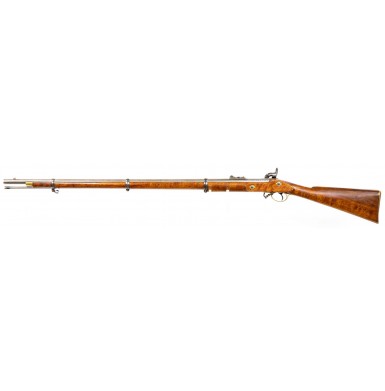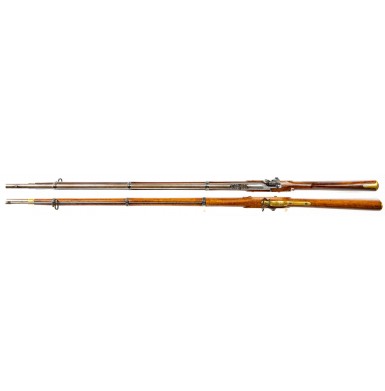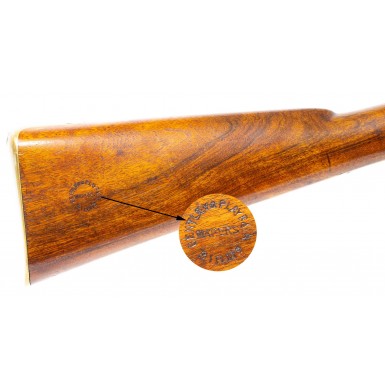Fine Pattern 1853 Enfield Rifle Musket by Bentley & Playfair
- Product Code: FLA-3568-SOLD
- Availability: Out Of Stock
-
$1.00
The Pattern 1853 “Enfield” Rifle Musket was the second most used infantry long arm of the American Civil War. The Pattern 1853 Enfield was an important weapon in military long arm history as it was the first “small bore” rifled long arm to see general issue to all British military personnel, effectively making every soldier a “rifleman” and eliminating both the smoothbore musket and the large caliber “Minié Rifle” as legitimate battlefield weapons. The reduced caliber .577” bore was a significant ballistic improvement over the .702” bore of the Pattern 1851 Minié Rifle and the overall design of the gun was the epitome of muzzle loading military firearms technology of the time. The P1853 would significantly influence the design of the new American Model 1855 Rifle Musket (and its replacements the M1861, Special Model 1861 and M1863/64) and would be the last of the percussion ignition, muzzleloading arms to see general service with the British military, being replaced by breechloading rifles about the time the Civil War came to an end. The P1853 was so revolutionary and so well designed that the “Enfield” was effectively the “AK-47” of the era, becoming the either the standard battle rifle for nearly every country in the world, or an equivalent “substitute standard”. Several million “Enfields” saw use across the globe during mid-19thcentury, so it is often difficult to determine if a specific Enfield rifle or rifle musket was here for the American Civil War, especially in the absence of specific US or CS markings on the gun. However, with somewhere in the neighborhood of one million Enfields being purchased and used by both sides combined during the course of the war, the very fact that the gun is here suggests that it may well be a veteran of that conflict
This Pattern 1853 Type III Enfield Rifle Musket is in FINE condition and is a classic example of the typical Civil War imported Enfield rifle musket. The gun is devoid of any British military markings and is a typical Birmingham made contract gun for commercial sale that was almost certainly destined for export. As a Birmingham produced gun it is also a wonderful example of the way the Birmingham Small Arms Trade worked during the mid-19thcentury with a master contractor assembling the gun from a variety of components made not only by himself but by other B.S.A.T. members. In this case the master contractor was Bentley & Playfair and is clearly stamped with their maker’s roundel on the obverse buttstock, reading BENTLEY PLAYFAIR BIRMH in a circle around the word MAKERS. The Bentley & Playfair trademark stamp B&P is also found stamped in the top of the barrel’s breech. The firm of Bentley & Playfair was a partnership between long-time Birmingham arms maker Joseph Bentley and Charles Playfair. Bentley had established his gunmaking business in 1829 at 11 Steelhouse Lane, advertising as a Saddle Pistol Maker. He remained at the Steelhouse Lane location through 1837 and by 1840 was located at 14 St. Mary’s Row. The previous year, Bentley had obtained his first British Patent #8024 for a pepperbox revolver, which he had designed in association with George Stocker. He received another patent in 1844 (#10,280 / 1844) for “nipples mounted parallel with the bore of guns”and in 1852 received his first patent regarding percussion revolver designs, with additional design improvements patented in 1854 (#768 / 1854). It was Bentley’s revolver designs that have made his name well-known to arms collector’s around the world. Three years before receiving his 1844 patent, Bentley was advertising his pepperbox design with in-line nipples by stating:
Joseph Bentley, Patentee and Manufacture of the Enclosed Central Fire Safety Gun, the Improved Self-Cocking, Revolving, Six-barreled Pistol. General Gun & Pistol Maker, for the Home and Foreign Markets.
In 1848, Bentley took Charles Playfair as a partner, establishing Bentley & Playfair, but retained his own business working at both the St. Mary’s Row address and 12 South Castle-Street in Liverpool until his death in 1864. The Bentley & Playfair firm was established as a typical Birmingham “Gun, Rifle & Pistol Maker” operation, initially located at 56 Summer Lane, from 1848-1859 and moving to 315 & 316 Summer Lane in 1860, where the firm would remain for some four decades! An 1860s advertisement for the firm read in part:
BENTLEY & PLAYFAIR, 315 & 316 Summer Lane, Birmingham, Manufacturers of Every Description of Military and Sporting Rifles, Guns, Pistols and Revolvers, and of the most Improved Breech Loaders…..Contractors to Her Majesty’s War Department.
Charles Playfair died in 1898, with the firm only surviving his passing by slightly more than a year, going out of business in 1900.
The lock of the gun is clearly marked with the typical British “Crown” to the rear of the hammer, but without the accompanying “VR” underneath that normally denotes British government ownership. The lock is marked 1861 / TOWER forward of the hammer. The interior of the lock is marked M over the mainspring, with the lock maker’s mark found around the mainspring boss, in this case R&W ASTON in an arc around the stud. In addition to being a well-respected Birmingham gunmaking firm, Richard & William Aston were well-known as a major gun lock making company as well. The assembly mating mark| |is found on the top edge of the lock and is also found on all of the major components, including under the barrel and in the ramrod channel of the stock. The barrel is marked at the breech with the three usual Birmingham commercial proofs: a Provisional Proof, a Definitive Proof and a Definitive View mark. These marks are separated by a pair of 25gauge marks, indicating that the gun is “25 bore” or .577 caliber. The underside of the barrel is marked with the usual assortment of initials, names and numbers. The barrel is marked with an Arabic 2to mate it with the balance of the gun, as well as the breech plug, with another M, as found in the lock and with the name of the barrel maker; John Clive. Clive was a prominent member of the B.S.A.T. producing high quality gun barrels. In fact, his initial location was at 14 St. Mary’s Row from 1814-1822, the same location Bentley had started his own business. In 1832, Clive became John Clive & Son, remaining in business through 1869, despite John Clive’s passing in 1833. The ramrod channel of the stock appears to read W BATES and is marked with the double slash assembly mark found elsewhere on the gun. This is likely the stock maker for the gun.
The gun is in FINE condition overall. The gun appears to be 100% original, complete and correct, with nearly every part from the barrel bands and major screw necks to the lock, stock and barrel having the same two slash mating assembly marks on them, or an Arabic “2”. The gun retains none of its original rust blued finish, having been “Struck Bright,” likely during the period of use or immediately thereafter. When firms like Schuyler, Hartley & Graham sold surplus Civil War Enfields in the post-war era, they were often listed as either being “blued” or “bright”, suggesting that not only were some actually struck bright in the field by Union regiments, but that guns in need of refurbishment prior to sale were often brightened with the remaining blue removed, rather than refinished. The metal has a slightly dull pewter patina with some scattered flecks and small patches of minor surface discoloration and minor oxidation and was likely lightly cleaned at some point in time. The metal is mostly smooth, with some scattered light pitting around the breech and some scattered pinpricking along the length of the barrel with some more light pitting on a couple of the barrel bands and in surrounding areas on the barrel. The bore of the gun is in about FINE condition with extremely crisp rifling along its entire length. The bore is mostly bright with only some scattered pinpricking and some very minor lightly pitting near the muzzle. A good cleaning might improve the bore even more. The lock of the gun retains some minute traces of the original case coloring on the exterior, primarily in the protected areas. Otherwise, it has a mottled gray patina with flecks and patches of darker metal, dulled traces of case hardening and some surface oxidation, all of which hint at its original mottled appearance. The interior of the lock retains somewhat more case coloring, which has faded and dulled. The lock is excellent mechanically and functions crisply and perfectly on all positions. The gun retains its complete and original rear sight, as well as the original combination front sight and socket bayonet lug. The gun retains both original sling swivels, one on the front of the brass triggerguard and the other on the tension screw for the upper barrel band. The original screw retention “doughnuts” are present on all three of the barrel band tension screws, a tiny part that is often missing from an Enfield when it is found today. The original full-length ramrod is in the channel under the barrel and retains good threads at the end. The rod is marked near the tip T&C / GILBERT in two lines, the mark of the Birmingham “Small Work” makers Thomas and Charles Gilbert who produced ramrods, gun tools, barrel bands and a variety of small parts for the gun trade. An original, period “snap cap” or nipple protector hangs from its chain attached to the triggerguard mounted sling swivel. The chain and protector are original and in nice shape, with some wear and loss to the leather, but the ring that holds the chain to the swivel is an old replacement. The brass furniture has a medium golden patina that matches the condition of the balance of the gun perfectly and is very attractive. The stock is in FINE condition as well. The wood to metal fit of the gun is wonderfully executed throughout, with no slop or gapping present. The stock is full-length, solid and free of any breaks, cracks or repairs. The stock has a really attractive medium honey brown color with some orange tones and a very attractive grain. The stock retains extremely sharp lines throughout and equally crisp edges and shows no indication of having been sanded. The stock appears to have been lightly cleaned at some point, but that is all. The stock does show a number of scattered bumps, dings and minor dents in the wood, as would be expected from a more than 150-year-old military musket but remains extremely crisp and sharp overall.
Overall, this is really fantastic example of a Civil War era Bentley & Playfair produced Pattern 1853 Enfield Rifle Musket. Despite the lack of bluing, the gun has the great appearance of a Union Army used Enfield that has been “struck bright” to match the M1861 Springfields carried by the regiment as well. The gun has tons of eye appeal and is so much crisper and sharper than most Enfields offered for sale these days that the difference is very obvious. If you have been waiting to add a really nice example of a Civil War era Enfield to your collection, now is your chance to get a very nice, “no apologies” gun that you will be very pleased to own and display.
ON HOLD / LAYAWAY
Tags: Fine, Pattern, 1853, Enfield, Rifle, Musket, by, Bentley, &, Playfair















